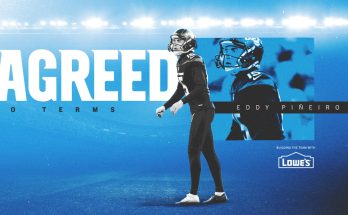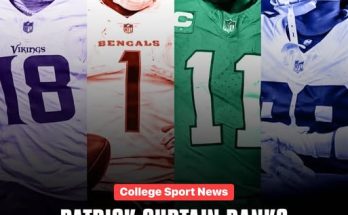In a groundbreaking development that has sent shockwaves through the collegiate sports community, Georgia Bulldogs safety Malaki Starks has reportedly secured an unprecedented $217 million Name, Image, and Likeness (NIL) deal. This monumental agreement not only redefines the financial landscape for student-athletes but also underscores the evolving dynamics of collegiate athletics in the NIL era.
Malaki Starks: A Rising Star
Malaki Starks, hailing from Jefferson, Georgia, has been a pivotal force in the Bulldogs’ defense since his freshman year. Known for his exceptional athleticism, keen football intelligence, and leadership both on and off the field, Starks has consistently demonstrated his value to the team. His on-field performances have garnered national attention, making him a prime candidate for lucrative endorsements and partnerships.
The Historic NIL Deal
The reported $217 million deal, facilitated by a Georgia Bulldogs football collective, spans the remainder of Starks’ collegiate career. This figure dwarfs previous NIL agreements, setting a new benchmark for student-athlete compensation. While specific details of the contract remain confidential, industry experts suggest that the deal encompasses a combination of direct financial compensation, equity stakes in partnered companies, and performance-based incentives.
Implications for Collegiate Athletics
Starks’ groundbreaking agreement signifies a transformative moment in collegiate sports. The introduction of NIL policies has empowered student-athletes to capitalize on their marketability, but a deal of this magnitude was previously uncharted territory. This development prompts several considerations:
-
Recruitment Dynamics: Universities may intensify efforts to attract top talent by leveraging potential NIL opportunities, leading to a more competitive recruitment landscape.
-
Equity and Fairness: The disparity between high-earning athletes and their peers could widen, raising questions about team cohesion and the equitable distribution of resources.
-
Regulatory Oversight: Such substantial deals may prompt the NCAA and other governing bodies to revisit and possibly revise NIL regulations to ensure transparency and fairness.
Comparative Analysis
To contextualize the enormity of Starks’ deal, it’s essential to examine previous high-profile NIL agreements. Before this, the largest reported NIL deals included:
-
Arch Manning: The Texas Longhorns quarterback secured a deal with Red Bull, elevating his NIL valuation to $6.6 million.
-
Bryce Underwood: A high-school quarterback recruit, Underwood obtained a $10 million NIL deal from Michigan’s collective, Champions Circle.
Starks’ $217 million agreement eclipses these figures, marking a paradigm shift in the valuation of collegiate athletes.
The Role of Collectives
The involvement of a Georgia Bulldogs football collective in facilitating Starks’ deal highlights the growing influence of such entities in the NIL ecosystem. Collectives, often comprising alumni and boosters, pool resources to create endorsement opportunities for athletes. Their participation can significantly enhance a program’s attractiveness to recruits, as evidenced by Starks’ landmark agreement.
Potential Challenges and Criticisms
While the financial benefits for athletes are evident, this development is not without potential challenges:
-
Academic Integrity: The allure of substantial financial gain may divert focus from academic pursuits, potentially compromising the educational mission of collegiate athletics.
-
Regulatory Scrutiny: Oversight bodies may impose stricter regulations to prevent potential abuses, such as inducements for recruitment or conflicts of interest.
-
Sustainability: The long-term viability of such massive deals is uncertain, especially if market dynamics shift or if return on investment for sponsors doesn’t meet expectations.
A New Era for Student-Athletes
Malaki Starks’ historic NIL deal is a testament to the evolving landscape of collegiate athletics. It reflects a broader societal shift towards recognizing and compensating the contributions of student-athletes. As the boundaries between amateur and professional sports continue to blur, stakeholders must navigate this new terrain thoughtfully, ensuring that the welfare and development of student-athletes remain paramount.
In conclusion, while Malaki Starks’ $217 million NIL deal sets a new precedent, it also serves as a catalyst for ongoing discussions about the future of collegiate sports, the role of education, and the rights and responsibilities of student-athletes in this rapidly changing environment.
The Impact on Georgia Football and the NCAA Landscape
Malaki Starks’ record-breaking $217 million NIL deal is not just a win for him but also a massive boost for the Georgia Bulldogs program. Georgia, already one of the premier programs in college football, now stands as an undisputed powerhouse in the NIL era. With this historic contract, the Bulldogs have set a new precedent for attracting top-tier talent, leveraging NIL opportunities to keep elite players within the program rather than losing them to the NFL or other schools with stronger NIL collectives.
The broader NCAA landscape is also bound to experience ripple effects from this deal. Other programs, especially in the SEC and powerhouse conferences like the Big Ten and ACC, may feel the pressure to match or exceed the financial incentives Georgia has made available to its athletes. This raises key questions about the long-term sustainability of NIL deals, the role of collectives, and whether the NCAA might implement stricter regulations to ensure parity in college football.
Recruiting Implications: A Game-Changer for College Football
Starks’ historic NIL deal will likely have profound implications for recruiting in college football. High school prospects are already considering NIL opportunities as a major factor when choosing a school, and Georgia’s ability to offer such an unprecedented financial package could give them a permanent advantage in securing the best recruits.
Some key recruiting implications include:
-
Increased NIL Focus in Recruiting Pitches
- Schools will not only have to showcase their athletic programs but also their ability to generate massive NIL deals for their players. Recruiting coordinators will emphasize a school’s partnerships, business connections, and booster support as selling points.
-
The “NIL Arms Race” Among Powerhouse Programs
- Other programs such as Alabama, Ohio State, Michigan, and USC will likely respond with larger NIL collectives and structured deals to stay competitive. This could lead to an era where financial backing becomes just as important as traditional recruiting elements like coaching, facilities, and winning records.
-
More Player Retention
- With this type of financial security available, elite college players may no longer feel the same urgency to leave early for the NFL. Starks’ deal is so significant that it could exceed the rookie contract value of a first-round NFL draft pick, making college football more appealing than ever.
The Business of NIL: Who’s Backing These Deals?
Starks’ record-setting deal showcases the growing power of NIL collectives and corporate sponsorships. The $217 million sum is likely a combination of several revenue sources, including:
-
Corporate Sponsorships: Major brands seeking to align with one of the best defensive players in college football will play a significant role in financing the deal. Companies in sports apparel, automotive, tech, and financial services may see Starks as the perfect ambassador for their products.
-
Equity Stakes in Companies: Some NIL deals now include stock options or business partnerships that allow players to profit long after their playing days are over.
-
Booster and Collective Contributions: Georgia’s NIL collective, backed by wealthy alumni and donors, likely facilitated a significant portion of the deal to ensure Starks remains with the Bulldogs.
-
Performance-Based Incentives: The contract may have clauses tied to Starks’ performance, such as All-American selections, championship appearances, or career milestones.
Is This Sustainable? The Future of NIL in College Sports
While Starks’ deal is a milestone in NIL history, it raises the question of sustainability. Can NIL collectives continue funding deals of this magnitude, or is this a one-off case for a truly generational player?
Potential Future Scenarios:
-
A “Salary Cap” for NIL Deals: The NCAA or conference regulators might step in to impose financial limits to maintain competitive balance.
-
Greater Revenue Sharing for Athletes: College sports could shift toward a model where NIL deals become more structured, ensuring a fairer distribution of money among players.
-
The NFL’s Response: If NIL deals continue to outpay rookie contracts, the NFL may need to revisit its draft eligibility rules, allowing players to enter the league earlier to prevent college football from overshadowing professional opportunities.
Starks’ Legacy: A Trailblazer in the NIL Era
Regardless of how the future of NIL evolves, Malaki Starks has cemented his legacy as a pioneer. His $217 million deal is not just a record-breaking moment—it is a defining shift in the relationship between athletes, universities, and financial opportunities in college sports.
For young athletes dreaming of playing college football, Starks represents a new era where talent, hard work, and marketability can translate into life-changing wealth without having to leave school.



